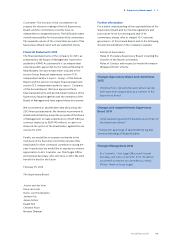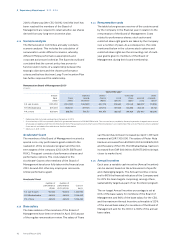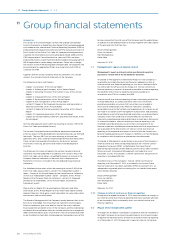Philips 2013 Annual Report Download - page 119
Download and view the complete annual report
Please find page 119 of the 2013 Philips annual report below. You can navigate through the pages in the report by either clicking on the pages listed below, or by using the keyword search tool below to find specific information within the annual report.10 Corporate governance 10.1 - 10.1
Annual Report 2013 119
the Board of Management shall hold the position of chairman of another
one-tier board or the position of chairman of another supervisory board. In
order for a company or foundation to be regarded as large, it must meet at
least two of the following criteria: (i) the value of the assets according to
the balance sheet with explanatory notes, considering the acquisition or
manufacturing price, exceeds EUR 17.5 million; (ii) the net turnover
exceeds EUR 35 million; or (iii) the average number of employees equals
or exceeds 250. During the financial year 2013 all members of the Board of
Management complied with the limitations on Non-Executive
Directorships described above.
Pursuant to new Dutch legislation on board diversity, eective January 1,
2013, the Company must pursue a policy of having at least 30% of the
seats on the Board of Management held by men and at least 30% of the
seats held by women. The rule will cease to have eect on January 1, 2016.
For more details on board diversity please be referred to the Report of
Corporate Governance and Nomination & Selection Committee in this
Annual Report.
New Dutch legislation on conflicts of interests, eective January 1, 2013,
provides that a member of the Board of Management may not participate
in the adoption of resolutions if he or she has a direct or indirect personal
conflict of interest with the Company or related enterprise. If all members
of the Board of Management have a conflict, the resolution concerned will
be adopted by the Supervisory Board. The Company’s corporate
governance includes rules to specify situations in which a (potential)
conflict may exist, to avoid (potential) conflicts of interests as much as
possible, and to deal with such conflicts should they arise. The rules on
conflicts of interests apply to the other members of the Executive
Committee correspondingly.
Relevant matters relating to conflicts of interests, if any, shall be
mentioned in the Annual Report for the financial year in question. No such
matters have occurred during the financial year 2013.
Amount and composition of the remuneration of the Board of
Management
The remuneration of the individual members of the Board of Management
is determined by the Supervisory Board on the proposal of the
Remuneration Committee of the Supervisory Board, and must be
consistent with the policy thereon as adopted by the General Meeting of
Shareholders. The current remuneration policy applicable to the Board of
Management was adopted by the 2013 General Meeting of Shareholders,
and is published on the Company’s website. A full and detailed description
of the composition of the remuneration of the individual members of the
Board of Management is included in chapter 9, Supervisory Board report,
of this Annual Report.
Pursuant to new Dutch legislation, eective January 1, 2014, the
remuneration of the members of the Board of Management and the
Supervisory Board must be included as a separate agenda item in the
convening notice for a general meeting of shareholders and must be dealt
with before the meeting can proceed to consider and adopt the Annual
Accounts.
The remuneration structure of the Company, including severance pay, is
such that it promotes the interests of the Company in the medium and
long-term, does not encourage members of the Board of Management to
act in their own interests and neglect the interests of the Company, and
does not reward failing members of the Board of Management upon
termination of their employment. The level and structure of remuneration
shall be determined in the light of factors such as the results, the share
price performance and other developments relevant to the Company.
Deviations on elements of the remuneration policy in extraordinary
circumstances, when deemed necessary in the interests of the Company,
will be disclosed in the Annual Report or, in case of an appointment, in
good time prior to the appointment of the person concerned.
The main elements of the contract of employment of a new member of the
Board of Management - including the amount of the fixed base salary, the
structure and amount of the variable remuneration component, any
severance plan, pension arrangements and the general performance
criteria - shall be made public no later than at the time of issuance of the
notice convening the General Meeting of Shareholders in which a
proposal for appointment of that member of the Board of Management
has been placed on the agenda. In compliance with the Dutch Corporate
Governance Code, the term of contract of the members of the Board of
Management is set at four years, and in case of termination, severance
payment is limited to a maximum of one year’s base salary; if the
maximum of one-year’s salary would be manifestly unreasonable for a
member of the Board of Management who is dismissed during his first
term of office, the member of the Board of Management shall be eligible
for a severance payment not exceeding twice the annual salary.
All current members of the Board of Management are employed by means
of a contract of employment. Pursuant to new Dutch legislation, eective
January 1, 2013, new members of the Board of Management will be
employed by means of a services agreement (overeenkomst van
opdracht).
From 2003 until 2013, Philips maintained a Long-Term Incentive Plan (‘LTI
Plan’) consisting of a mix of restricted shares rights and stock options for
members of the Board of Management, Philips executives and other key
employees. A fully revised LTI Plan applicable to members of the Board of
Management was approved by the 2013 General Meeting of Shareholders.
The revised plan consists of performance shares only, with a three year
post-grant performance measurement. For more details please be
referred to the section 9.2, Report of the Remuneration Committee, of this
Annual Report.
The so-called ultimum remedium clause and claw-back clause of best
practice provisions II.2.10 and II.2.11 of the Dutch Corporate Governance
Code are applicable to Annual Incentive payments and LTI grants for the
year 2009 onwards to all members of the Board of Management. In
respect of the LTI grants, the ultimum remedium clause can be applied to
the performance-related actual number of stock options, restricted share
rights and/or performance shares that is granted. In addition, pursuant to
newly adopted Dutch legislation, eective January 1, 2014, the
Supervisory Board will be authorized to change unpaid bonuses awarded
to members of the Board of Management if payment or delivery of the
bonus would be unacceptable according to the principles of
reasonableness and fairness. The Company, which in this respect may
also be represented by the Supervisory Board or a special representative
appointed for this purpose by the General Meeting of Shareholders, may
also claim repayment of bonuses paid or delivered (after December, 31,
2013) insofar as these have been granted on the basis of incorrect
information on the fulfillment of the relevant performance criteria or other
conditions. Bonuses are broadly defined as ‘non-fixed’ remuneration,
either in cash or in the form of share-based compensation, that is
conditional in whole or in part on the achievement of certain targets or the
occurrence of certain circumstances. The explanatory notes to the
balance sheet shall report on any moderation and/or claim for repayment
of board remuneration. The newly adopted legislation also introduces an
obligation for the Company to reduce the remuneration of a member of
the Board of Management, if and to the extent the value of such member’s
share-based remuneration would have increased as a result of the
announcement of a large transaction (requiring shareholder approval) or a
public oer for the Company.
Members of the Board of Management hold shares in the Company for the
purpose of long-term investment and are required to refrain from short-
term transactions in Philips securities. According to the Philips Rules of
Conduct on Inside Information, members of the Board of Management are
only allowed to trade in Philips securities (including the exercise of stock
options) during ‘windows’ of twenty business days following the
publication of annual and quarterly results (provided the person involved
has no ‘inside information’ regarding Philips at that time unless an
exemption is available). Furthermore, the Rules of Procedure of the Board
of Management and Executive Committee contain provisions concerning
ownership of and transactions in non-Philips securities by members of the
Board of Management. Members of the Board of Management are
prohibited from trading, directly or indirectly, in securities of any of the
companies belonging to the peer group, during one week preceding the
disclosure of Philips’ annual or quarterly results. These rules referred to
above in this paragraph apply to members of the Executive Committee
correspondingly. Transactions in shares in the Company carried out by
members of the Board of Management or members of the Supervisory
Board and other Insiders (if applicable) are notified to the Netherlands
Authority for the Financial Markets (AFM) in accordance with Dutch law
and, if necessary, to other relevant authorities.
Indemnification of members of the Board of Management and
Supervisory Board
Unless the law provides otherwise, the members of the Board of
Management and of the Supervisory Board shall be reimbursed by the
Company for various costs and expenses, such as the reasonable costs of
defending claims, as formalized in the Articles of Association. Under
certain circumstances, described in the Articles of Association, such as an
act or failure to act by a member of the Board of Management or a member
of the Supervisory Board that can be characterized as intentional
(‘opzettelijk’), intentionally reckless (‘bewust roekeloos’) or seriously
























